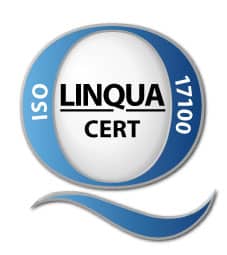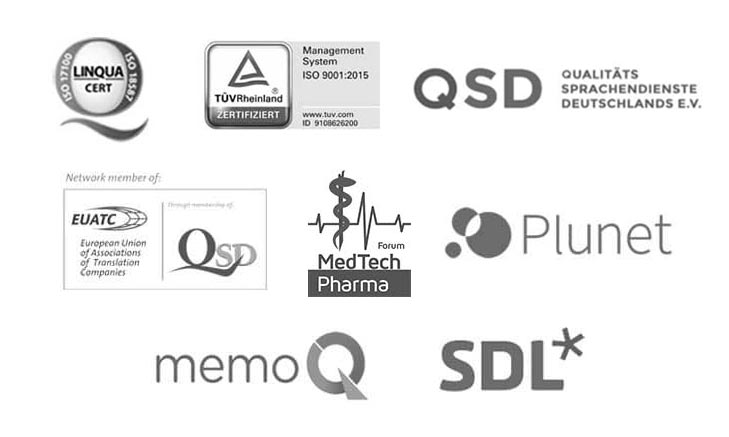Quality

mpü – quality doesn’t happen by chance
The mpü quality standard – the steps to getting a high-quality product
To do justice to this statement, we developed a quality management system that takes into account the specific requirements of DIN EN ISO 9001 and DIN EN ISO 17100 in both technical translations and all other process steps.
A network of over a thousand selected linguists –
the best in the industry
All of our linguists are native speakers of the target language and accredited experts in their subject areas. They are selected and tested by mpü around the world and accredited by national and international associations of translators and interpreters.
Certification – ISO 17100 and more
From the standard to added value
mpü’s translation management approach prioritises translation quality and security and is based on the international ISO standards.
- Translation quality
is ensured and certified at each step according to DIN EN ISO 17100 - Quality management
is certified according to DIN EN ISO 9001:2015.
Health authorities require ISO 17100 quality
The FDA, EMA, ethics committee and notified bodies
require translation quality according to DIN EN ISO 17100 for
- Registration procedures for medicinal products
e.g. product information - Clinical trials of medicinal products
e.g. patient information and informed consent (PIC),
insurance policies for patients,
questionnaires (e.g. Quality of Life QoL, PROMs) - New regulations in the MDR and IVDR for medical devices and IVDs
e.g. package leaflets
We stand for these high-quality, medical, pharmaceutical and medical technology translations, and our certifications prove this.
You can view the certificates directly: Certificates

The DIN EN ISO 17100 process standard
DIN EN ISO 17100 is a standard which specifically regulates the process steps and quality standards for translation services with the aim of ensuring a consistently high-quality translation product. In addition to the technical translation step, this standard covers not only the revision and verification steps, but also lays out requirements and prerequisites for all those involved in a translation project.
For us at mpü, that didn’t go far enough. With our mpü Quality Assurance Check, we check again to make sure that the translation meets our quality criteria.
But for documents which will be published, such as product information sheets, operating instructions, websites, etc., there can be far-reaching consequences if translations are unsatisfactory or incorrect, such as a tarnished image, liability losses or personal injury, and these translations should be carried out in accordance with the strictest quality assurance criteria.
mpü-Prozessschritte des Qualitätsmanagements
1 Translation request
more…
- Source/target language
- Volume
- Delivery date
- Target group
- Style guides
- Customer specifications/instructions
- File format
of source/target text - Additional services e.g. DTP
2 Source text analysis
more…
- Areas of expertise
- Target group – Language style
- Regulatory requirements
- File format editable
- Volume feasible
- Reference material
- Writing suitable for translation
3 File preparation
more…
- Selection of translation memory
- Selection of terminology
DB or glossary - Pre-translation
- Segmentation
4 Selection of translator and reviewer
more…
- Native translator
- Customer-specific translator
- Established experience in the subject area
- Recognised degree
- At least two years of full-time professional experience
5 Technical translation
more…
- Established experience in the subject area with the customer-specific term base and translation memory
- Personal check of the finished translation
6 Revision DIN EN ISO 17100 + finalisation
more…
- The same specifications as technical translation
- Taking into account
- Reference material
- Style guide
- Operating procedures
- Customer specifications
- Check for
- Completeness
- Spelling
- Grammar
- Punctuation
- Understandability
- Terminology
- if necessary regulatory examination
- Translators check all changes and suggestions from the reviewer
- Creation of the final version including quality check
- If there are any differences of opinion the translators discuss it between themselves or if necessary with the customer
7 Quality assurance check
more…
- Spelling
- Completeness
- Language variant rules (EN: UK-US, ES: EU-LAC, etc.)
- Numbers and units
- Product names (incl. registered symbols)
- Consistency within the text (based on repeating segments)
- Terminology consistency (against term base, if available)
8 Verification
more…
- Project manager verifies that all project specifications have been complied with.
9 DTP if required
more…
- File formats
- Format conversion
- Different language-specific typesets and character sets
- Word, syllable and sentence separation
- Amendment/adaptation of text lengths
- Corporate design guidelines
- Quality assurance:
- Typesetting and line break check by a native speaker
10
Transcreation if required
more…
- Aim: Look and feel
- Transcreation of the final translation.
- Customer-specific language style/style guide
- Internationalisation (colours/images/logo – target country)
- Terminology and product names
- if required revision by a second copywriter
11 Customer correction if required
more…
- Customer feedback
- If required review by
foreign subsidiaries - Process on request
12 Feedback loop verification
more…
- Implementation of customer feedback in the translation memory and term base
- Check of customer corrections against the glossary for consistency
Quality assurance checks as part of a multi-step system
Depending on the type of project and document, electronic quality tools are used to identify any errors in the translation. The mistakes are then checked by a project manager to determine whether they are valid. Any eventual doubts are clarified in collaboration with our customers and translators.
Tools mean that the modern translation and language process is manageable, transparent and more efficient – that is, faster, more cost effective and of higher quality.
It is essential to perform a comprehensive range of diverse checks and quality assurance steps because checking the translation quality occurs throughout the entire translation and correction process in a variety of ways.
The reviewer checks the translation quality, and the final check by the technical translator during the finalisation can also identify additional errors. Our in-house QA then identifies the remaining discrepancies in the text.
Of course our quality assurance check also compares the translation against your
- Style guides,
- Linguistic and technical customer specifications,
- Customer feedback,
- References,
- Terminology entries and
- Translation memories.
While our multi-step quality assurance workflow is based on the ISO 17100 guidelines, mpü enhances this framework by adding in additional measures specific to each customer.
Our quality assurance check
- Completeness
- Grammar, punctuation, etc.
- Numbers and number formats
- Spell check and language variant rules (EN: UK – US, ES: EU – LAC, etc.)
- Product names (incl. registered symbols)
- Terminology check (consistency and customer-specific terminology databases, if applicable)
Our labelling quality check
- EMA QRD templates including Annexes I–IV and Appendices I–V
- National templates such as BfArM, Swissmedic and others
- EDQM Standard Terms
- Lay terms in PL (MHRA, AGES)
- Excipients guidelines
- Non-standard abbreviations
- MedDRA terminology (mpü database)
- MedDRA side effects and system organ classes
- Blue box requirements – adaptation

At mpü, quality doesn’t happen by chance – your contacts are always expert partners.
Experienced team of expert project managers and quality managers
Our highly-qualified and highly-motivated team of
- Qualified translators,
- Linguists and translation scientists,
- Scientists,
- Terminologists,
- IT experts and
- Management scientists
is ready and waiting for your projects.
The PMs are responsible for meeting all quality criteria and finding the best solutions, from project analysis and preparation to final delivery, while always expertly coordinating customer requirements, technologies and those working on the project.
Customers can be confident they will get personalised and professional customer care because they will be assigned a dedicated project manager.
Goal-oriented customer communication
Partnership – commitment – reliability
We place a lot of value on active customer contact and open and targeted communication between customers, partners and employees is how we achieve our reliable quality.
TAILORED
TRANSLATION PROCESSES TO FIT WITH YOUR BUDGET
The standardised workflow/process of quality assurance is tailored to the specific quality requirements of our customers.
Not every translation project needs all of the quality steps.
We find the best solution to align your budget with your requirements for the translation project.
MANAGEMENT OF QUERIES
We also manage queries professionally to ensure early communication to avoid errors.
Feedback loop
With different departments in a company, outside subsidiaries and partners, post-processing of projects and translations and revising terminology databases optimises the translation quality on an ongoing basis.
Our common goal is responsibility to our customers and the best result for their projects.

3,000 technical translators –
1 address
Vendor management
Qualifications of the native-speaker technical translators and subject experts
Our quality assurance starts before the project begins with the careful selection and qualification of our linguists and subject experts by our resource management team.
We carefully select and test our worldwide network of several thousand native-speaker, qualified and technically trained
linguists:
technical translators and revisors, copywriters, medical/creative writers, copy editors, post-editors, terminologists
+
subject matter experts:
doctors, pharmacists, chemists, biochemists, medical engineers,
marketing specialists, IT specialists, lawyers.
mpü requires excellent qualifications as stipulated in DIN EN ISO 17100 and they are determined on the basis of
- Language ability
- Native language qualification
- Expertise in the target country/culture
- Many years of in-depth experience in a specialist field or discipline
- Technological skills
- If required additional qualification for revision and post-editing
- Reliability and delivery reliability
- Confidentiality agreement.
They are also accredited by translation and interpreting associations as qualified linguists and experts in their subject areas.
| BDÜ | Bundesverband der Dolmetscher und Übersetzer – Germany |
| ITI | Institute of Translation and Interpreting – UK |
| ATA | American Translators Association – USA |
| IMIA | International Medical Interpreters Association – USA |
| AITI | Associazione Italiana Traduttori e Interpreti – Italy |
| TAC | Translators Association of China – China |
| JAT | Japan Association of Translators – Japan |
| SFT | Société Française des Traducteurs – France |
| Asetrad | Asociación Española de Traductores, Correctores e Intérpretes – Spain |
| ADAT | Association of Danish Authorized Translators – Denmark |
| ATIM | Association of Translators, Terminologists and Interpreters of Manitoba – Canada |
| AUSIT | Australian Institute of Interpreters and Translators – Australia/Oceania |
Customer team – regular translators – partners
Customers are assigned dedicated teams of specialist native-speaker translators and revisors from our expert pool, which ensures consistent and systematic adherence to all client specifications and forms the basis for efficient collaboration and a positive partnership.

We know our vendors/translators as well as we know our customers. The internal QA check combines this knowledge and makes a difference to the quality.
Ongoing improvement to text quality using terminology management
Companywide and cross-departmental adherence to specialist terminology and corporate language
Consistent corporate language ensures a uniform appearance and high recognition value for your company.
Terminology is an important knowledge carrier in a company and defined, standardised corporate and technical language leads to improved communication, both within the company and externally.
Language consistency processes
The translation database (translation memory) and the terminology database provide the basis for our language consistency processes, which are carried out, managed and monitored by our project managers.
Get in touch!
We would be happy to identify the right quality steps for your project.


